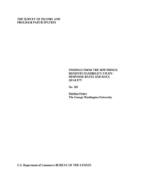Findings from the SIPP Fringe Benefits Feasibility Study: Response Rates and Data Quality
Findings from the SIPP Fringe Benefits Feasibility Study: Response Rates and Data Quality
In August 1987 the U.S. Bureau of the Census conducted a special survey to determine the feasibility of collecting information from employers about their contributions for health insurance, life insurance, and private pension plans on behalf of specified individuals in their employ. This special survey, known as the SIPP Employer Fringe Benefits Survey (which for simplicity is referred to below as "the survey"), was conducted at the end of the last wave, i.e., the 8th wave, of the 1985 panel of the Survey of Income and Program Participation (SIPP). An objective of the survey, besides the primary one of determining the response rate, and the one we report on in this paper was to ascertain the characteristics of individuals who were least likely to participate in the field test. Such information is useful in determining the extent of selectivity bias present in the survey and in deciding how much time to allocate to different individuals so as to increase the response rate. Another objective that will be taken up in a later study was to obtain provisional estimates of the dollar amounts employers contribute to finance the fringe benefit noted above. Interest in the latter stems from the continuing effort by the Census Bureau to improve its estimates of income by including in income the value of government and private in-kind transfer payments (see U.S. Bureau of the Census, 1988).
Since household survey respondents typically are unable to provide information about employer fringe benefit contributions, it was necessary to obtain a signed waiver from respondents permitting the Census Bureau to obtain the desired information from their employers. Thus the overall survey response rate depends on the response rate of respondents in signing the waiver and the response rate of employers in returning the survey questionnaire to the local Census Bureau field office.
As indicated the survey was primarily undertaken to determine whether response rates would be sufficiently high to warrant the collection of fringe benefit data from a larger sample. The rates reported in this paper are based on summary figures supplied by Census Bureau field offices and other summary data compiled by the author. As mentioned, the goal of this paper is to gain some insight into the characteristics of workers who are least likely to sign a waiver given the response rate of respondents and employers.
If individuals have different propensities of signing a waiver permitting a Federal government agency to obtain information from their employers, it is plausible, as a first approximation, to assume they fall into one of two groups. The first group can be thought of as consisting of persons who regard with suspicion any governmental effort to obtain information about their lives. Individuals in the second group may take a more benign view of the uses made by government of the data that it collects and may be more willing to provide information about themselves.
The major conclusion of the study is that there was only a weak relationship between the propensity to sign the waiver and variables related directly or indirectly to socioeconomic status. Other SIPP data not contained in the fringe benefit survey on the other hand indicate that there is a strong positive relationship between socio-economic status, e.g., as measured by education, and the decision to refer to W-2 forms in providing the Census Bureau with accurate earnings information. This latter finding that the better educated are more likely to refer to their W-2 forms is somewhat surprising in light of the reluctance of better educated,, and presumably wealthier, individuals to provide wealth data. One possible explanation for the findings of this study is that the perception of what constitutes the provision of sensitive information differs in different contexts. Why this is so is obviously the subject matter of a larger study than this one.
Others in Series
Working Paper
Working Paper
Working Paper






